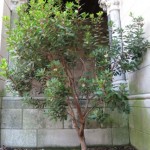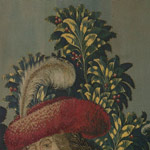 |
 |
 |
Above, from left: A strawberry tree growing in a sheltered corner in Trie garden; Arbutus unedo in fruit in the woodland of The Unicorn At Bay; the evergreen strawberry tree bears flowers and fruit simultaneously in late October.
A native of the Mediterranean, the strawberry tree (Arbutus unedo) is valued as an ornamental evergreen whose late-blooming flowers and red fruits enliven the garden in late fall and early winter, when few other species are of interest. The common name derives from the description of the tree made by Pliny the Elder, who compares the fruit, with its thin, rough, red rind, to that of the strawberry, Fragaria vesca. He believed the two plants to be related, and states that the strawberry is the only fruit that grows both on a bush and on the ground, although he acknowledges that the flesh of the two fruits is quite different (Historia Naturalis, Book XV.xxviii. 98-99). The fruit of the arbutus much more closely resembles that of the lychee, although they are not botanically related. The specific epithet unedo (from the Latin unum edo, or “I eat one”) derives from the same passage. According to Pliny, the fruit is so insipid that no one who has tasted it will be tempted to eat another.
I’ve never??tasted the??“strawberries”??myself, and our own specimen, although flowering freely, has no fruit to sample this year. (The tree is at the limit of its cold-hardiness here at The Cloisters, and it suffered some winter damage last year. We were forced to prune the wood that had died back, thus sacrificing this year???s fruit.) Many people do describe the fruit as bland and uninteresting, but not everyone. For a long and lively discussion of its flavor and for recipes for making both preserves and a traditional Portuguese liqueur called medronheira from arbutus fruit, see the comments appended to the Plant Portrait on the Plants For A Future Database.
Dioscorides mentions the fruit of the arbutus without assigning any medicinal virtues to it. He warns that it is bad for the stomach and that it causes headaches (De Materia Medica, Book 1.175). Although Dioscorides may be referring to a related species, Arbutus andrachne, also found in Greece, the sixteenth-century herbalist John Gerard applied these caveats to A. unedo, and followed Pliny in his description of the fruit as being without relish, although he notes that thrushes and other birds are fond of it.
???Deirdre Larkin
Sources:
Alexander, E. J., and Carol H. Woodward. The Flora of The Unicorn Tapestries. Second edition. New York: The New York Botanical Garden, 1947.
Anderson, Frank J., ed. ???Herbals through 1500,??? The Illustrated Bartsch, vol. 90. New York: Abaris, 1984.
Dirr, Michael. Manual of Woody Landscape Plants. Fourth edition. Champaign, IL: Stipes Publishing Company, 1990.
Grieve, Maude. A Modern Herbal. 1931. Reprint: New York: Dover Publications, 1971.
Grigson, Geoffrey. The Englishman???s Flora. 1955. Reprint: London: J. M. Dent & Sons, 1987.
Gunther, Robert T., ed. The Greek Herbal of Dioscorides Translated by John Goodyer 1655. 1934. Reprint. New York: Hafner Publishing, 1968.
Tags: Arbutus unedo, strawberry tree
